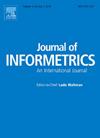Predicting technological convergence with multi-channel graph neural networks: A case study of CRISPR
IF 3.5
2区 管理学
Q2 COMPUTER SCIENCE, INTERDISCIPLINARY APPLICATIONS
引用次数: 0
Abstract
Identifying emerging technological convergence is essential for anticipating future innovation trajectories. Existing approaches typically rely on either International Patent Classification (IPC) co-occurrence networks, which capture general combination frequencies, or association rule networks, which emphasize statistically significant and often higher-order relationships. However, these two structural views are rarely integrated, limiting their effectiveness in representing both the breadth and depth of technological linkages. To address this gap, we propose a Multi-Channel Graph Convolutional Network (MC-GCN) that treats IPC co-occurrence and association rule networks as structurally distinct inputs. While co-occurrence data reflect raw interaction patterns, association rules—derived via data mining—serve as a refined signal that highlights meaningful and potentially multi-IPC convergence patterns. Our model encodes each view through separate GCN channels and fuses their embeddings within a unified representation space. To establish a comprehensive evaluation, we also include topological link prediction baselines such as Common Neighbors, Adamic–Adar, and Preferential Attachment in our comparative analysis. Applied to CRISPR-related patent data, the MC-GCN significantly outperforms single-channel models, achieving an AUC of 0.973 when combined with XGBoost. Furthermore, five predicted IPC combinations were validated in newly granted patents in early 2025, demonstrating the model’s practical utility in forecasting real-world technological convergence.
用多通道图神经网络预测技术收敛:以CRISPR为例
识别新兴的技术融合对于预测未来的创新轨迹至关重要。现有方法通常依赖于捕获一般组合频率的国际专利分类(IPC)共现网络,或强调统计显著且通常是高阶关系的关联规则网络。然而,这两种结构观点很少结合起来,限制了它们在表示技术联系的广度和深度方面的有效性。为了解决这一差距,我们提出了一种多通道图卷积网络(MC-GCN),它将IPC共发生和关联规则网络视为结构上不同的输入。虽然共现数据反映了原始的交互模式,但通过数据挖掘派生的关联规则作为精细的信号,突出了有意义的和潜在的多ipc融合模式。我们的模型通过单独的GCN通道对每个视图进行编码,并将它们的嵌入融合到统一的表示空间中。为了建立全面的评价,我们还在比较分析中加入了共同邻居、亚当-阿达尔和优先连接等拓扑链路预测基线。应用于crispr相关专利数据时,MC-GCN显著优于单通道模型,与XGBoost联合使用时AUC达到0.973。此外,2025年初,五种预测的IPC组合在新授予的专利中得到了验证,证明了该模型在预测现实世界技术融合方面的实际效用。
本文章由计算机程序翻译,如有差异,请以英文原文为准。
求助全文
约1分钟内获得全文
求助全文
来源期刊

Journal of Informetrics
Social Sciences-Library and Information Sciences
CiteScore
6.40
自引率
16.20%
发文量
95
期刊介绍:
Journal of Informetrics (JOI) publishes rigorous high-quality research on quantitative aspects of information science. The main focus of the journal is on topics in bibliometrics, scientometrics, webometrics, patentometrics, altmetrics and research evaluation. Contributions studying informetric problems using methods from other quantitative fields, such as mathematics, statistics, computer science, economics and econometrics, and network science, are especially encouraged. JOI publishes both theoretical and empirical work. In general, case studies, for instance a bibliometric analysis focusing on a specific research field or a specific country, are not considered suitable for publication in JOI, unless they contain innovative methodological elements.
 求助内容:
求助内容: 应助结果提醒方式:
应助结果提醒方式:


